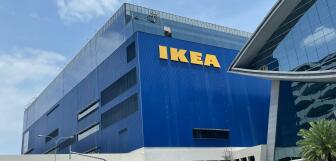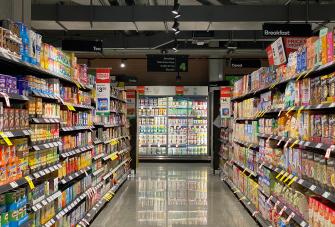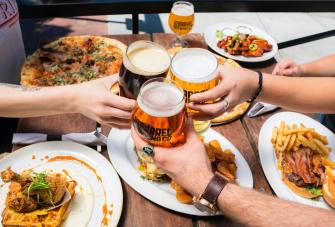What Is a Big Box Store?
You know those giant stores you can spot from the highway? They’re like retail cities. Aisles so long you can’t see the end. Shelves stacked higher than your head.
These are big box stores, and here in the US, they make up around 82% of the retail market. That’s… almost everything.
They promise more for less and somehow, even when prices go up everywhere else, they hold the line. Take Costco as an example. Since the 1980s, their hot dog and soda combo has been $1.50. Not a penny more. If it kept up with inflation, it’d be $4.40 today.
These types of retail operations use low prices on popular items to bring customers in the door. Once you’re inside, you’ll find a huge range of products, often at prices that other stores can’t beat.
From Walmart’s grocery aisles to Home Depot’s tool sections, big box stores have changed the way we shop, making convenience and low prices the norm.
But there’s more to the story. How do they manage to keep prices so low? What does their dominance mean for smaller stores and local communities?
Today, we'll explore the rise of big box stores, how their business model works, and what it means for all of us (but particularly those smaller retail business owners).
Definition and origins
Before we get into the nuts and bolts of how these stores operate and what we can expect to see from them in the future, let's first get really clear on what these large-format stores are.
Physical form – the “big box” architecture
Big box stores are instantly recognizable because of their size and shape.
They’re usually one huge building, often rectangular, with a plain exterior and large parking lots out front. These specialty retailers essentially look like large warehouses.
These stores are designed for efficiency with wide aisles, tall shelves, and open floor plans that let them stock thousands of products all in one place.
They're also great for efficiency and getting customers in and out of the door as quickly as possible. Many follow a self-serve shopping model with DIY shopping and self-service kiosks.
Definition – large-scale, high-volume retail model
At its core, a big box retailer is a large-scale, high-volume retailer. They sell a huge variety of products (we're talking groceries and clothing to electronics and home improvement supplies) all under one roof.
Because they buy products in massive quantities, they get better deals from suppliers. Those savings get passed on to customers in the form of lower prices.
This model is built around volume: more customers buying more products every day keeps the business profitable, even with lower profit margins on individual items.
Types of big box stores
Chances are you’ve visited a big-box store at least once in your life. Here are some you may have come across.
General merchandise Big‑Box
These stores carry a wide range of products all under one roof. Think Walmart. With over 10,500 stores worldwide, this is one of the largest big box chains in the US, selling everything from fresh produce and clothes to electronics and home goods. A typical Walmart is around 182,000 square feet, making it a massive one-stop shop.
Target is another example, with nearly 2,000 stores across the US. Target sells sports gear, entertainment items, baby products, groceries, and more.
Fun fact: most Americans live within 10 miles of one, showing just how common this retail store is.
Specialty Big‑Box
These big-box stores focus on one main category, offering a huge selection within that niche.
Home Depot is a perfect example, with more than 2,300 stores specializing in home improvement, tools, and appliances.
They hold over 12% market share among competitors and employ nearly half a million people.
Hypermarkets
Hypermarkets combine grocery shopping with general merchandise, giving customers the convenience of getting everything in one place. Tesco, based in the UK, is a great example. It’s the third-largest retailer worldwide with over 4,600 locations, each averaging 70,000 square feet.
Costco is another type of hypermarket, though it operates more like a membership warehouse club. With only 884 stores worldwide, Costco’s locations range from 80,000 to 230,000 square feet.
How big box stores operate
Here's the 411 on how big big stores work:
Economies of scale & low pricing strategy
Big box stores work because they buy huge amounts of products at once. This is called economies of scale. When big box retailers purchase goods in bulk, they get deep bulk discounts from suppliers.
These savings let big box chains offer lower prices than many smaller or specialty retailers can match. This is why you often hear about their unbeatable deals.
This low pricing strategy is a core part of how large big box retail stores compete in the market.
One‑stop‑shop convenience
Instead of visiting multiple small box retail or specialty stores, shoppers can get everything they need in one trip.
This saves time and effort for busy shoppers. Plus, many big box grocery stores and big box wholesale stores include extra services like pharmacies or optical centers.
This convenience is a major draw, making big box retailers a go-to choice for millions of people every week.
Impact on small businesses & local retailers
While a big box outlet store offers low prices and convenience, these large stores' growth has a big impact on small businesses and local retailers.
Small retailers and specialty stores often struggle to compete on price. This can lead to local businesses closing, which affects the character and economy of communities.
Some people worry that the dominance of big box retail stores reduces choices for consumers and concentrates too much power in a few large retailers.
On the other hand, big box outlets can also bring jobs and economic activity to areas.
Understanding the balance between the benefits and drawbacks of big box store expansion is key when asking about the big box store meaning, significance, and how it shapes modern retail.
Big box vs other retail formats
When we talk about big box stores, it’s helpful to see how they compare to other types of retail formats. Each has their own strengths and weaknesses:
|
Feature |
Big box stores |
Small-box retailers / Micro-retailing |
Specialty stores / local businesses |
|
Size |
Very large (often 80,000–200,000+ sq ft) |
Small to medium-sized stores |
Small to medium-sized stores |
|
Product Variety |
Huge selection across many categories |
Limited selection, often focused |
Narrow focus, deep expertise in category |
|
Pricing |
Low prices due to bulk buying power |
Higher prices, less discounting |
Often premium pricing for specialty items |
|
Customer Service |
Basic, self-service |
More personalized and flexible |
Highly personalized, expert advice |
|
Convenience |
One-stop shop, everything under one roof |
May require visits to multiple stores |
Focused, but may require shopping elsewhere |
|
Impact on Community |
Can challenge local small businesses |
Often community-focused and local |
Strong community ties, supports local economy |
|
Examples |
Walmart, Costco, Home Depot |
Local grocers, boutiques, small chains |
Local bookshops or bicycle shops |
Scale fast, evolve faster with Epos Now Enterprise
Discover how our comprehensive suite of point-of-sale solutions can propel your large-scale enterprise forward, delivering unparalleled efficiency, scalability, and insight across retail, hospitality, leisure, and services sectors.
Why it matters for consumers and retailers
Consumer benefits
- Low prices due to bulk buying and economies of scale
- Wide product variety across many categories
- Convenient one-stop shopping experience
Consumer challenges
- Crowded stores can make shopping stressful. It can be easy to get super over-stimulated
- Less personalized customer service compared to specialty or local stores
- Limited expert advice or tailored recommendations in retail sales
TIP: Learn more about retail problems and solutions in our guide!
Retailers: competition, distribution advantages
For retailers, big box chains are powerful competitors. Their size and buying power make it tough for smaller local businesses and specialty stores to compete on price and selection.
However, these large retailers also benefit from advanced distribution networks and efficient retail operations that help keep shelves stocked and prices competitive. Their ability to move products quickly across many locations is a huge advantage in today’s fast-paced market.
What drives the big box trend?
There’s a lot behind why big box stores keep growing and winning customers. Let’s break down the key reasons they’ve become such a huge part of how we shop today.
Real estate & regional planning
Big box stores love big spaces with lots of parking, easy highway access, and room to grow. Town planners often set aside areas just for these giant stores because they bring in traffic and jobs.
Supply chain & inventory logistics
These stores have massive warehouses and smart POS systems to keep shelves stocked without overdoing it. Good supply chains mean products arrive on time and customers can rely on finding what they want.
Digital integration & omnichannel strategy
Big box retailers are blending online shopping with in-store pickup, apps, and same-day delivery. This mix makes it easy for shoppers to buy how and when they want.
Final thoughts
Big box stores are everywhere, and they’ve changed the way we shop offering huge variety, low prices, and convenience all under one roof.
But that doesn’t mean small retailers and specialty shops are out and can't compete.
In fact, there’s plenty of ways smaller stores can stand out and keep customers coming back:
- Get to know your customers, offer expert advice like retail upselling, and focus on the kind of personalization that they won’t find in a big box store.
- Offer unique products or services that big box stores don’t have. Think local, handmade, or niche.
- Partner with other local businesses or get involved in events to build strong local support.
- Run retail loyalty programs so that your customers keep coming back to you, and you alone.
- Set up a simple online shop or use social media marketing to connect with customers.
- Invest in tech like a retail POS system to help you access real-time customer data.
- Host workshops, demos, or special events that turn shopping into something fun and memorable.
Big box stores are big for a reason, but small stores have the power to be personal, unique, meaningful. With the right approach, you can compete and hit those retail KPIs you want.
FAQs
- How do big box retailers differ from specialty stores?
-
Big box stores have tons of stuff and low prices, while specialty shops focus on specific things and offer more personal help.
- What are common examples of big box retail chains?
-
Think Walmart, Costco, Home Depot, Target, and IKEA.
- How do big box stores affect small businesses?
-
They make it hard for small shops to compete because big box stores are usually cheaper and super convenient.
- Why are prices often lower at big box stores?
-
They buy lots of items at once and run things super efficiently, so they can sell stuff cheaper. Doing some retail cash flow analysis as a small business can help you to compete.
- What are the advantages and disadvantages of shopping at big box stores?
-
- Good: low prices, lots to choose from, and easy to get what you need.
- Bad: can be crowded and not much personal help.




